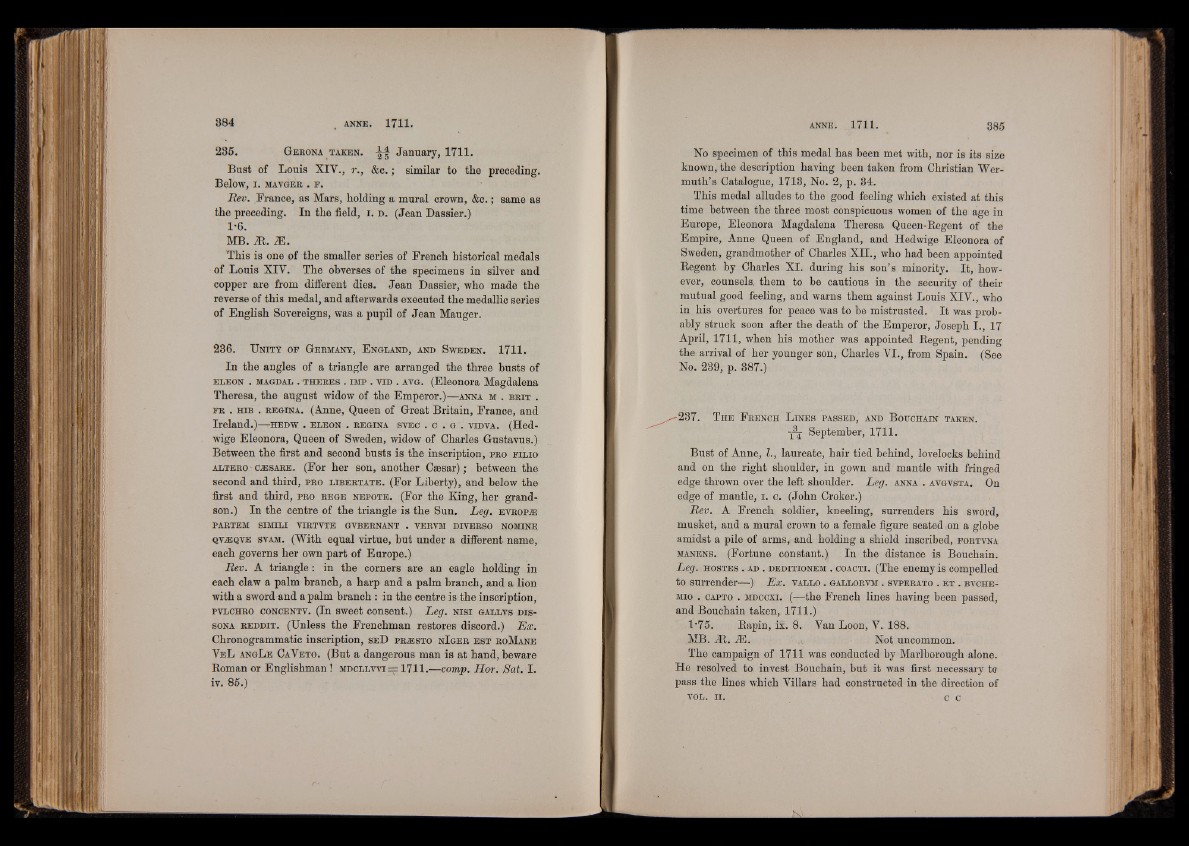
Bust of Louis XIV., r., &c.; similar to the preceding.
Below, I . MAVGER . F .
Rev. France, as Mars, holding a mural crown, &c.; same as
the preceding. In the field, i . d . (Jean Dassier.)
1-6.
MB. M. M .
This is one of the smaller series of French historical medals
of Louis XIV. The obverses of the specimens in silver and
copper are from different dies. Jean Dassier, who made the
reverse of this medal, and afterwards executed the medallic series
of English Sovereigns, was a pupil of Jean Mauger.
236. U n it y o f G e rm a n y , E n g la n d , and Sw e d e n . 1711.
In the angles of a triangle are arranged the three busts of
e l e o n . magdal . t h e r e s . im p . v id . a v g . (Eleonora Magdalena
Theresa, the august widow of the Emperor.)— anna m . b r it .
f r . h ib . r e g in a . (Anne, Queen of Great Britain, France, and
Ireland.)—h e d w . e l e o n . r e g in a sv e c . c . g . v id v a . (Hed-
wige Eleonora, Queen of Sweden, widow of Charles Gustavus.)
Between the first and second busts is the inscription, pr o f il io
a l t e r o c js sa r e . (For her son, another Caesar); between the
second and third, p r o l ib e r t a t e . (For Liberty), and below the
first and third, p r o r e g e n e p o t e . (For the King, her grandson.)
In the centre of the triangle' is the Sun. Leg. ev r o p je
PARTEM SIMILI VIRTVTE GVBERNANT . VERVM DIVERSO NOMINE
qvaiqve svam. (With equal virtue, but under a different name,
each governs her own part of Europe.)
Rev. A triangle: in the corners are an eagle holding in
each claw a palm branch, a harp and a palm branch, and a lion
with a sword and a palm branch : in the centre is the inscription,
pv l c h r o c o nc entv . (In sweet consent.) Leg. n i s i g a l lvs d is -
sona e e d d it . (Unless the Frenchman restores discord.) Ex.
Chronogrammatic inscription, s e D p r e s t o n I g e r e s t r oM a ne
V e L angL e C aV e t o . (But a dangerous man is at hand, beware
Boman or Englishman ! m dc l lv v i = 1711.—comp. Hor. Sat. I.
iv. 85.)
No specimen of this medal has been met with, nor is its size
known, the description having been taken from Christian Wer-
muth’s Catalogue, 1713, No. 2, p. 34.
This medal alludes to the good feeling which existed at this
time between the three most conspicuous women of the age in
Europe, Eleonora Magdalena Theresa Queen-Begent of the
Empire, Anne Queen of England, and Hedwige Eleonora of
Sweden, grandmother of Charles XII., who had been appointed
Begent by Charles XI. during his son’s minority. It, however,
counsels, them to be cautious in the security of their
mutual good feeling, and warns them against Louis XIV., who
in his overtures for peace was to be mistrusted. It was probably
struck soon after the death of the Emperor, Joseph I., 17
April, 1711, when his mother was appointed Begent, pending
the arrival of her younger son, Charles VI., from Spain. (See
No. 239, p. 387.)
-237. T h e F r e n c h L in e s p a s s e d , and B o u ch a in t a k e n .
September, 1711.
Bust of Anne, I., laureate, hair tied behind, lovelocks behind
and on the right shoulder, in gown and mantle with fringed
edge thrown over the left shoulder. Leg. anna . avgvsta. On
edge of mantle, i. c. (John Croker.)
Rev. A French soldier, kneeling, surrenders his sword,
musket, and a mural crown to a female figure seated on a globe
amidst a pile of arms, and holding a shield inscribed, fo r tv n a
m a n en s . (Fortune constant.) In the distance is Bouchain.
Leg. h o s t e s . ad . d e d it io n em . co ac t i. (The enemy is compelled
to surrender— ) Ex. vallo . gallorvm . sv per ato . e t . b v c h e -
m io . capto . m dc c x i. (—the French lines having been passed,
and Bouchain taken, 1711.)
V75. Bapin, ix. 8. Van Loon, V. 188.
MB. At. 2E. i Not uncommon.
The campaign of 1711 was conducted by Marlborough alone.
He resolved to invest Bouchain, but it was first necessary to
pass the lines which Villars had constructed in the direction of
VOL. I I . c c